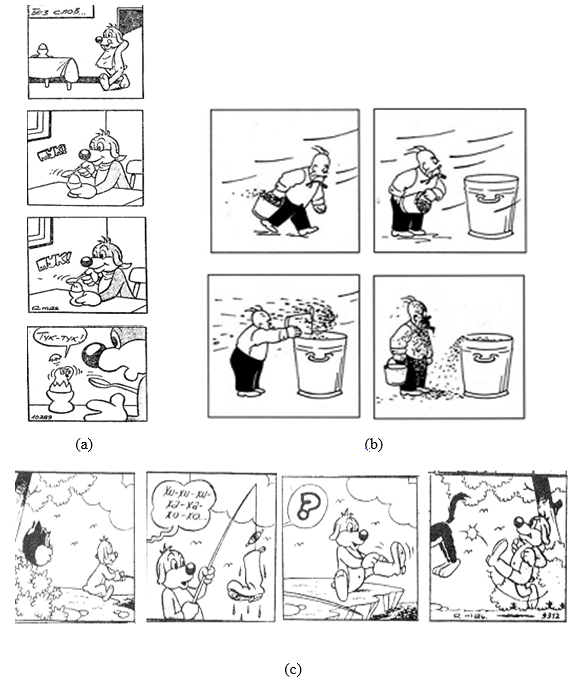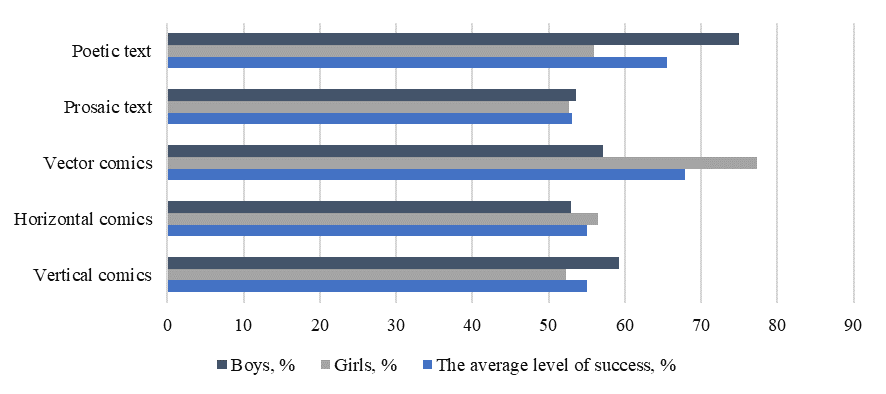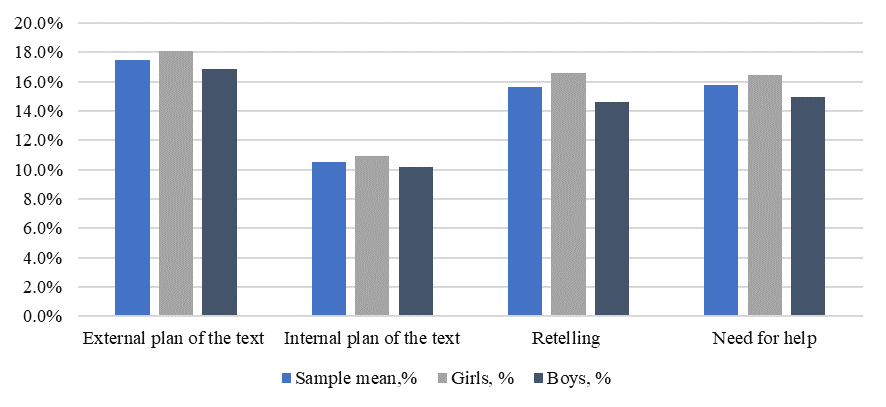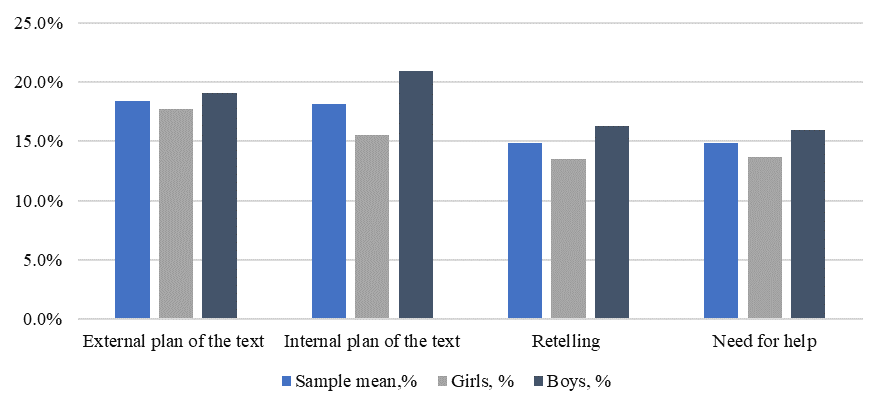Abstract
The article is devoted to the issue of the accessibility of understanding polycode narratives for students in primary grades. It is shown that narrative texts encountered in the experience of younger schoolchildren can be presented both in the traditional linguistic (printed) form and as a visual narrative (comics, graphic stories). The peculiarities of perception and understanding of visual narrative are related to the configuration of visual information, which is important for the selection of polycode texts as a didactic tool. Such texts are especially effective for the development of the textual competence of elementary schoolchildren at the initial stage of education but can be integrated into educational material during the entire period of study at the stage of primary general education. According to the survey the success of primary school students in understanding a vector-type polycode narrative text was found. Gender differences while working with various types of narratives were revealed: girls demonstrate great success in working with polycode narratives and boys – with text narratives.
Keywords: Comicspolycode textreadingunderstanding narratives
Introduction
The tendency of the development of modern education is caused by the transition to a new format of educational space with a multimodal nature. A large role in its equipment is played by visual practices, multimodal and polycode means. The latter, among other things, include polycode texts – “texts in which the language code is combined with codes of a completely different semiotic system (visual, acoustic, kinesthetic, etc.). Moreover, the non-linguistic part carries an independent but dependent on the linguistic information load” (Shulekina, 2018).
Research in the field of psycholinguistics (Cohn, 2013; Dunst et al., 2018) indicates the differential feature of such texts – the asymmetry of the information which is contained in them. It means that instead of linear way of interpretation of the content by means of a system of linguistic signs, as it occurs in a traditional language text, here the content is mediated by the interaction of the code structures of the text, some of which may prevail and even suppress others depending on the context. That is why the mechanisms of semantic perception differ in comparison with the perception of a traditional text during reading. Otherwise the integrative work of cognitive functions is included in the processing of sign information (Brenna, 2012; Martín-Arnala et al., 2019; Schnotz, 2014). Despite the complexity of the interaction of the codes, they retain the main signs of the semantic integrity of the text as a language unit – an optional title; the division into paragraphs, which is provided, for example, by modularity and digital marking; logical completeness; the ability to formulate the concept of the text by linguistic means (Shulekina, 2018).
Problem Statement
Today the concept visual literacy is becoming more popular and therefore, a large number of empirical studies in education and psychology are devoted to the study of visualization (Fu et al., 2019; McVicker, 2018; Richter et al., 2016). Infographics are actively used as a new space for reading, learning and developing mental skills (Parkinson, 2016; Wang et al., 2019; Yildirim, 2016). So, polycode texts are actively integrated into modern education as a mean of improving the quality of children’s education. For example, in English-speaking countries nowadays public policy stimulates the education system to use polycode texts as a tool to support students in the study space. The corpus of special visual texts is a part of the general basic state standards, especially for teaching the native (English) language (Bakis, 2012; Edwards, 2019).
Many authors see the connection between the ability to read comics and reading a language text. Despite the fact that some teachers still pay little attention to comics as a didactic resource, the attitude to comics is changing in actual educational space. Today most researchers emphasize the importance of skills to understand comics for the development of educational literacy, including the mastery of reading and writing (Afrilyasanti & Basthomi, 2011; Barbee, 2015; Bowkett, 2011; Briggs, 2015; Dallacqua, 2012; Drolet, 2010). All of these authors show the comics’ advantages in learning students reading and writing skills, which are the part of different types of literacy.
Comics are very important tool for the development of children's thinking processes and text comprehension. On the basis of visual literacy, it is possible to develop metacognitive thinking skills (Kholodnaja & Gelfman, 2016; Marshall, 2018; Mendez Leon & Cardenas, 2018). Research confirms that the developed skills of understanding visual material are transferred to the skills of understanding the language text in traditional reading.
Research Questions
Evaluation of understanding processes in children of primary school age on the basis of visual narratives, which include comics, is significant for studying the educational opportunities of different students in the cognitive processing of complex polycode information in a comprehensive (including inclusive) school. While reading graphic texts, children do not passively perceive information but interact both with text and pictures to construct meaning. Moreover, a great didactic potential is detected in the application of polycode texts while working with children who have special educational needs (Shulekina, 2018).
The list of research questions includes the following:
Is there a difference in understanding traditional language and visual narrative texts?
What types of texts are most preferable for primary school children in the study group as a whole?
How do girls and boys understand different types of texts separately?
Purpose of the Study
In this regard our multidisciplinary team of researchers has chosen the study target. We intended to test the hypothesis about the various mechanisms of understanding polycode and traditional language narrative texts by children of primary school age, as well as to identify the gender characteristics of using these text types using empirical material.
Research Methods
The assessment of primary school students’ thinking skills in various types of narratives during the research was carried out on the basis of a sample of second-grade students of Moscow mainstream schools who do not have deviations in intellectual and speech development. The sample was formed on the basis of a deterministic approach, based on the simplicity of establishing contacts with students in order to obtain information necessary for conducting the research. The sample included 94 students – 52 girls (55.3%) and 42 boys (44.7%). The structure of the obtained sample makes it possible to objectively evaluate gender differences in the development of skills while using narrative materials in elementary school.
The experiment was organized in accordance with the technology by Ju. Shulekina (2018) and adapted to the objectives of this study. All the participants of the survey were offered various types of tasks with narrative texts – to read, answer the questions on the text and retell. The texts were presented both in the traditional linguistic form (“As a hedgehog was walking in the woods” by G. Tsyferov; “About Stepan and sour cream”, a children's counting rhyme), as well as the polycode form (comics: 1) “Pifa’s breakfast” and 2) “Pifa’s fishing”, 3) comic book “Wind”). The polycode stimulus material was chosen so that the order of frames in each comic was different: the comic book “Pifa’s breakfast” had a vertical arrangement of frames, the comic book “Pifa’s fishing” had a horizontal arrangement of frames, the comic book “Wind” had a vector structure assuming a zigzag perception of the order of the main hero’s actions. Images of comic texts are shown in figure

The ability of second-grade students to work with narrative texts of various types was evaluated according to the following parameters:
• Understanding the external plan of the text associated with the analysis of the linear order of sentences organized according to linguistic rules and reflecting the semantic content of the text.
• Understanding the internal plan of the text. It means understanding the semantic organization of the material, including the hidden meaning.
• Modeling of one’s own history, that is, retelling the text in your own words following the traces of looking or reading the text.
• The need for help when working with a text – the need to obtain various types of verbal support from the experimenter (suggestive and specific questions, introductory words, gestures initiating speech activity, etc.) and the effectiveness of their usage by students.
Each parameter had an assessment scale: total task completion (25%), partial task completion (12.5%) and task failure (0%). The overall success of the participants in the experiment was the sum of the points scored for each of four parameters. Based on these criteria, the estimated range of a particular pupil can vary from 0% (complete lack of skills) to 100% (maximum level of skills development while working with narrative material).
The following final scale for assessing the success of studied students in each type of narrative material and during the whole experiment is proposed to use by us (table
The study assessed the success of working with narrative material both as a whole in the sample and according to gender structure. The final assessment was carried out by averaging the estimated values of each student according to:
types of studied narrative materials;
evaluated parameters in accordance with the methodology;
gender structure of the sample.
Averaging was carried out using the arithmetic mean of average (formula 1). A similar method was used in the study of the authors (Shulekina & Dmitrieva, 2019).
, (1)
where n - the number of the studied contingent of primary school students during the experiment;
xi - the obtained estimated values for each studied parameter.
Findings
The results of assessing the success of students in the context of individual types of narrative materials and in the whole experiment are shown in table
The results which are clearly presented in table
So, the data in table
When assessing success for certain types of work, it should be noted that the highest level of success was demonstrated by students working with vector comics (67.9%) and poetic texts (65.5%). It is necessary to pay attention to the significant gender difference according to these types of narratives: while working with vector comics, the average success rate for girls was 77.3%, while the average success rate for boys was 57.1%. Vice versa, when working with poetic texts, the boys showed an average success rate of 75.0%, while the average success rate for girls was 56.0%. The evaluation of the success while working with horizontal comics and a prosaic text during the experiment did not reveal significant gender differences.

We also consider, it is necessary to pay attention to the general heterogeneity of the plurality in terms of the parameter for evaluating the success of work with all types of narrative texts. According to this parameter the coefficient of variation is 43.22% (which is significantly higher than 33%, which is a measure of the homogeneity of the plurality) and the dispersion of the success level for separate pupils ranges from 12.5% to 100%, which is typical for elementary school classes in ordinary comprehensive schools in Moscow.
The coefficient of variation was determined on the basis of the standard methodology for its calculation – by the ratio of the standard deviation to the average value of the success rating for all types of narratives (formula 2) [2]:
(2),
where is the average success for all types of narratives;
is standard deviation, which is calculated by the formula (formula 3):
(3)
Further, during the processing of experimental data, we estimated the average level of success of the pupils for each parameter of the assessment as a whole for the sample and taking into account gender differences (tables
The data in tables
Very interesting results were obtained during a consolidated assessment of the success of working with polycode and text (monocode) narratives, the results of which are presented in table
The results which are presented in table
The explicit gender differences while working with different types of narratives should be noted: girls demonstrate greater success in mastering skills while working with polycode narratives (table
Boys, on the contrary, are significantly ahead of girls in terms of working with textual narratives in all evaluated parameters, as it is shown by columns 6 and 7 of table
According to the authors, such results may be the result of males’ accelerated development of abstract thinking compared with females already at the stage of education in elementary school.
Graphically, the results of an average assessment of the success of students with polycode and text narratives are presented in figures


Conclusion
According to the current stage of the study the following preliminary conclusions were suggested:
Gender differences of the second-grade students in the formation of skills while working with various types of narratives were determined: boys demonstrate advancing skills in working with textual (monocode) narratives, and girls demonstrate with polycode.
Among the narratives presented in various modalities, visual narratives (comic book) and poetic narratives are the best for second-grade students’ understanding. At the same time, the order of frames in the visual narrative (comic) is important for a better understanding of the content and the construction of meaning. Comics with vector frames turned out to be the most understandable for children of the studied age in comparison with comics with horizontal and vertical frames. The conclusion is confirmed by the obtained results of the experiment with second-grade students of primary schools in Moscow: with an average value of the success rate of working with various types of narratives at the level of 59.3%, students demonstrated success in working with vector comics at the level of 67.9 %, and with poetic texts – at the level of 65.5% with the highest possible assessment of the success of working with narrative materials in the amount of 100%.
During the research it was determined that students have difficulties in understanding the essential basis of narrative materials: the percentage of success in understanding the internal plan of the narrative was 13.6%, with the maximum possible grade for this parameter being 25.0%. The best results were demonstrated by students in terms of formal perception of narratives: with an understanding of the external plan, the average success rate was 17.9% with the maximum possible estimate of the parameter at 25%.
In terms of understanding the essential basis of narrative materials, a significant superiority was also found in the perception of the content of text narratives compared to polycode ones: with the highest possible success rate of 25%, the average estimated value for understanding the internal plan of the text is 18.2% for text narratives, and for polycodes – only 10.5%, which is a very significant difference. In this regard, we consider it is necessary to continue research on this issue.
References
- Afrilyasanti, R., & Basthomi, Y. (2011). Adapting Comics and Cartoons to Develop 21st Century Learners. Language in India, 11(11), 552-568.
- Bakis, M. (2012). The graphic novel classroom: Powerful teaching and learning with images. Thousand Oaks. Corwin Press.
- Barbee, M. (2015). Comic Books as Models for Literacy Instruction. International Reading Association. Retrieved from https://www.literacyworldwide.org/blog/literacy-now/2015/08/12/comic-books-as-models-for-literacy-instruction.
- Bowkett, S. (2011). Using comic art to improve speaking, reading and writing. Routledge, Taylor & Francis.
- Brenna, B. (2012). How Graphic Novels Support Reading Comprehension Strategy Development in Children. Literacy Journal. UKLA, 47, 88-94.
- Briggs, S. (2015). Reading with Pictures: Serious Learning Through Comics. https://www.opencolleges.edu.au/informed/features/reading-with-pictures-serious-learning-through-comics/
- Cohn, N. (2013). The visual language of comics: Introduction to the structure and cognition of sequential images. Bloomsbury.
- Dallacqua, A. K. (2012). Exploring Literary Devices in Graphic Novels. Language Arts, 9(6), 365-378.
- Drolet, C. A. (2010). Using Comics in the Development of EFL Reading and Writing. SungKyul University.
- Dunst, A., Laubrock, J., & Wildfeuer, J. (2018). Empirical Comics Research: Digital, Multimodal, and Cognitive Methods. Routledge.
- Edwards, K. D. (2019). Texts as Tools: Engaging Students in Reading to Complement Hands-On Activities. https://www.questia.com/read/1G1-568147867/texts-as-tools-engaging-students-in-reading-to-complement.
- Fu, X., Wang, Y., Dong, H., Cui, W., & Zhang, H. (2019). Visualization Assessment: A Machine Learning Approach. IEEE Visualization Conference (VIS), 126-130.
- Kholodnaja, M. A., & Gelfman, E. G. (2016). Developing educational texts as a tool of intellectual education of students. RAN Institute of Psychology Press.
- Marshall, J. (2018). The Power of Comics. https://literacyworldwide.org/blog%2Fliteracy-daily%2F2018%2F12%2F20%2Fthe-power-of-comics
- Martín-Arnala, L. A., Leóna, J. A., Broekb, P., & Olmosa, R. (2019). Understanding Comics. A Comparison between Children and Adults through a Coherence. Incoherence Paradigm in an Eye-tracking Study. Psicología Educativa, 25(2), 127-137.
- McVicker, C. J. (2018). Visual Literacy And Learning To Read: Using Comic Strips for Reading Instruction. Journal of Visual Languages & Computing. No. 8. https://www.researchgate.net/publication/327043053_Visual_Literacy_And_Learning_To_Read_Using_Comic_Strips_for_Reading_Instruction
- Mendez Leon, A. P., & Cardenas, B. A. (2018). Improving reading comprehension through comics as a narrative text. Monography. Сorporación universitaria minuto de dios education faculty.
- Parkinson, M. (2016). Infographic tips and tools. Talent Development, 70(5), 26-28.
- Richter, J., Scheiter, K., & Eitel, A. (2016). Signaling text-picture relations in multimedia learning: A comprehensive meta-analysis. Educational Research Review, 17, 19-36.
- Schnotz, W. (2014). An Integrated Model of Text and Picture Comprehension. In R. E. Mayer (Ed.), Cambridge Handbook of Multimedia Learning (2nd edition, pp. 72-103). Cambridge University Press.
- Shulekina, J. A. (2018). Modern technologies for working with a textbook in inclusive education. MCU Press.
- Shulekina, J. A., & Dmitrieva, O. V. (2019). The Formation Working Skills with a textbook in primary school children. Vestnik MCU, 4, 83-92.
- Wang, Z., Wang, S., Farinella, M., Murray-Rust, D., Henry Riche, N., & Bach, B. (2019). Comparing Effectiveness and Engagement of Data Comics and Infographics. CHI '19 Proceedings of the 2019 CHI Conference on Human Factors in Computing Systems, Glasgow, Scotland Uk, 253. https://doi.org/10.1145/3290605.3300483
- Yildirim, S. (2016). Infographics for educational purposes: Their structure, properties, and reader approaches. Turkish Online Journal of Educational Technology, 15(3), 98-110.
Copyright information

This work is licensed under a Creative Commons Attribution-NonCommercial-NoDerivatives 4.0 International License.
About this article
Publication Date
20 November 2020
Article Doi
eBook ISBN
978-1-80296-094-5
Publisher
European Publisher
Volume
95
Print ISBN (optional)
-
Edition Number
1st Edition
Pages
1-1241
Subjects
Sociolinguistics, discourse analysis, bilingualism, multilingualism
Cite this article as:
Shulekina, J. A., Dmitrieva, O. V., Borodina, M. A., & Kireeva, I. P. (2020). Narratives Of Which Modality Are The Most Accessible For Younger Students’ Understanding?. In Е. Tareva, & T. N. Bokova (Eds.), Dialogue of Cultures - Culture of Dialogue: from Conflicting to Understanding, vol 95. European Proceedings of Social and Behavioural Sciences (pp. 1175-1185). European Publisher. https://doi.org/10.15405/epsbs.2020.11.03.124

